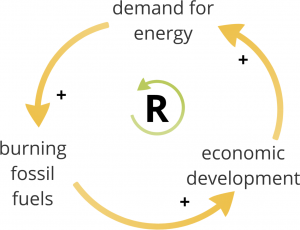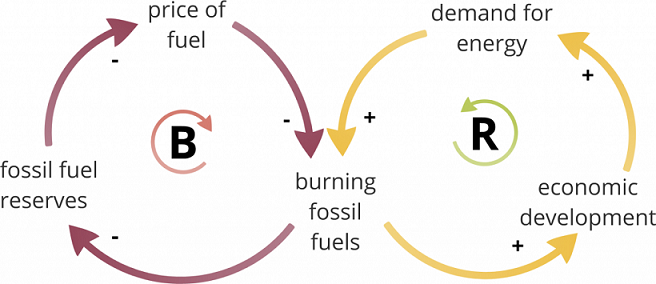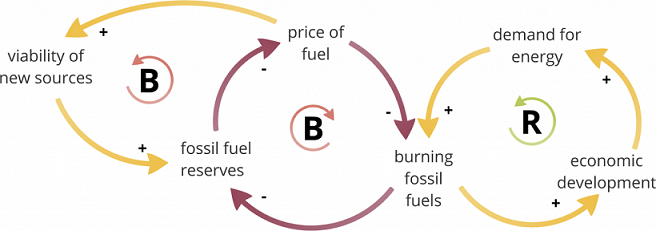
|
Mother Pelican
A Journal of Solidarity and Sustainability
Vol. 10, No. 3, March 2014
Luis T. Gutiérrez, Editor
|
|
|
|

|
|
|
The Climate as a System
Part 2: Energy Consumption Loops
Steve Easterbrook
Originally published in Serendipity, 26 August 2013
REPRINTED WITH PERMISSION
This is Part 2 of a series of articles
exploring the complex feedback dynamics of
GLOBAL CLIMATE CHANGE
For an analysis of the recently released IPCC report, click HERE
For a syllabus on systems thinking for global issues, click HERE
|
|
In part 1, I described the central equilibrium loop that controls the earth’s temperature. Now it’s time to look at other loops that interact with central loop, and tend to push it out of balance. The most important of these is the use of fossil fuels that produce greenhouse gases, which change the composition of the atmosphere. Let’s first have a look at energy consumption on its own. Here’s the basic loop:

Core economic growth and energy consumption loop
|
This reinforcing loop has driven the growth in the economy and energy use since the beginning of the industrial era. As we might expect from a reinforcing loop, this dynamic creates an exponential curve – in both the size of the global economy and the consumption of fossil fuels. For example, here’s the curve for carbon produced per year from fossil fuels (data from CDIAC):
For the first century, the curve looks flat, but it’s not zero. In 1751 the world was producing about 3 tonnes of carbon per year, and this rises to about 50 tonnes per year by 1851. The growth really gets going in the postwar period. There are dips for global recession in the 1930s and 1980s, but these barely dent the overall rise. (For a slightly more detailed exploration of the dynamics that drive this exponential growth, see the Postcarbon Institute’s 300 years of fossil fuels in 300 seconds).
Exponential growth cannot go on forever, so there must be a balancing loop somewhere that (eventually) brings this growth to a halt. The world’s supply of fossil fuels is finite, so if we keep climbing the exponential curve, we must eventually run out. But long before that happens, prices start to rise because of scarcity. So the actual balancing loop looks like this:

The "peak oil" balancing loop for economic growth
|
In this new loop, each link inverts the direction of change: as consumption of fossil fuels rises, the remaining reserves fall. As reserves fall, the price tends to go up. As the price goes up, the rate of consumption falls. It’s a balancing loop because (once it starts operating) each rise in fossil fuel prices should cause a price rise that then damps down further consumption.
If these two loops operate on their own, we might expect an initial exponential curve in the use of fossil fuels, until there are signs that reserves are being depleted, and then a gradual phasing out of fossil fuels, producing the classic bell-shaped curve of Hubbert’s peak theory. In the process, economic development would also grind to a halt, unless we manage to decouple the first loop fairly quickly, by switching to renewable sources of energy. In theory, the rising price of fossil fuels should cause this switch to happen gracefully, once prices start rising – a properly functioning economic system should guarantee this. Unfortunately, the switch is not easy, because we’ve build a massive energy infrastructure that is based exclusively on fossil fuels, and this locks us in to a dependency on fossil fuels. This lock-in, along with the exponential growth in demand, means that we cannot just switch to alternative energy as the prices rise – a more likely outcome is an overshoot, where the rate of consumption is stuck in an upwards trend, causing prices to shoot up, while the balancing loop is unable to do its stuff.
However, there’s another complication. Conventional sources aren’t the only way to get fossil fuels. As the price rises, other sources become viable. The classic example is the Alberta oil sands. Twenty years ago, nobody could extract these because it was too expensive, compared to the price of oil. Today, the price of oil is high enough that exploiting the oil sands becomes profitable. So there’s another loop:

The "tar sands" balancing loop
|
This new loop balances the rising prices from the middle loop when reserves start to fall. So now we have a system that could keep the economy functioning well beyond the point at which we exhaust conventional sources of fossil fuels. At each new price point, there’s a stimulus to start tapping new sources of these fuels, and as these new sources come on stream, they allow the global economy to keep growing, and the consumption of fossil fuels to keep rising. To someone who just studies economics of energy, everything looks okay for the foreseeable future (except that cheap oil is never coming back). To someone who predicts doom because of peak oil, it complicates the picture (except that the resource depletion predictions were basically correct). But to someone who studies climate, it means the challenge just got harder…
ABOUT THE AUTHOR
Steve M. Easterbrook is a professor of Computer Science at the University of Toronto. Professor Easterbrook's research is focused on software engineering for climate system modeling, and the following is a list of recent publications:
- Engineering the Software for Understanding Climate Change, Steve M. Easterbrook and Timothy C. Johns, IEEE Computing in Science and Engineering, November 2009.
- Climate Change: A Software Grand Challenge, Steve M. Easterbrook, Serendipity, 24 August 2010.
- Guest Editors’ Introduction: Climate Change - Science and Software, S. M. Easterbrook, P. N. Edwards,V. Balaji, R. Budich, IEEE Software, 2011
- Why Systems Thinking?, Steve M. Easterbrook, Serendipity, 20 August 2013.
- The Climate as a System, part 1: the central equilibrium loop, Steve M. Easterbrook, Serendipity, 22 August 2013.
- The Climate as a System, part 2: energy consumption, Steve M. Easterbrook, Serendipity, 26 August 2013.
- The Climate as a System, part 3: greenhouse gases, Steve M. Easterbrook, Serendipity, 27 August 2013.
- The Climate as a System, part 4: earth system feedbacks, Steve M. Easterbrook, Serendipity, 2 September 2013.
- The Climate as a System, part 5: clouds, Steve M. Easterbrook, Serendipity, 3 September 2013.
-
What Does the New IPCC Report Say About Climate Change?, Steve M. Easterbrook, Serendipity, 8 October 2013.
- Systems Thinking for Global Problems, Steve M. Easterbrook, Graduate Course Outline, University of Toronto, 2 December 2013.
For more information about this author, see his UT Webpage and his Serendipity Blog.
|
|Back to Title|
Page 1
Page 2
Page 3
Page 4
Page 5
Page 6
Page 7
Page 8
Page 9
Supplement 1
Supplement 2
Supplement 3
Supplement 4
Supplement 5
Supplement 6
PelicanWeb Home Page
|
|
|
|
"The family is one of nature's masterpieces."
— George Santayana (1863-1952)
|
|
Page 8
|
|
FREE SUBSCRIPTION
|
![[groups_small]](groups_small.gif)
|
Subscribe to the
Mother Pelican Journal
via the Solidarity-Sustainability Group
Enter your email address:
|
|
|
|